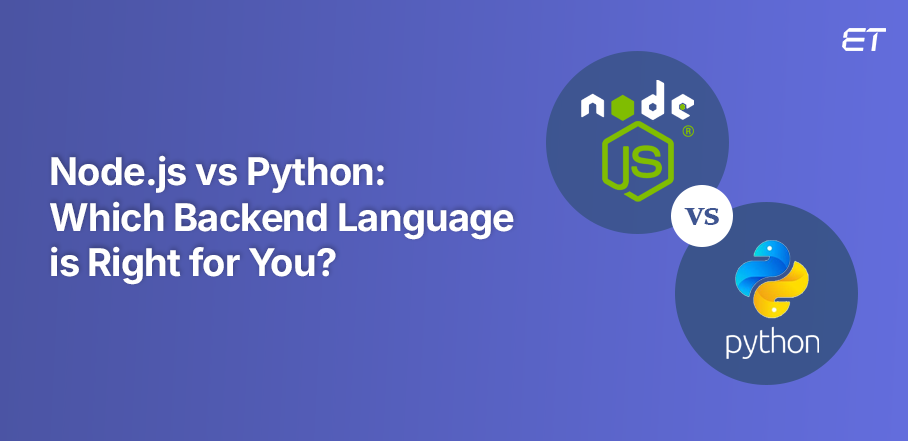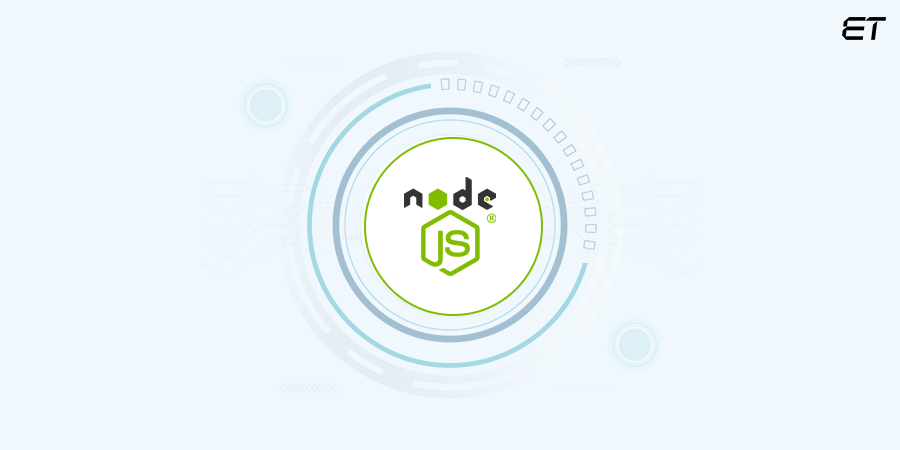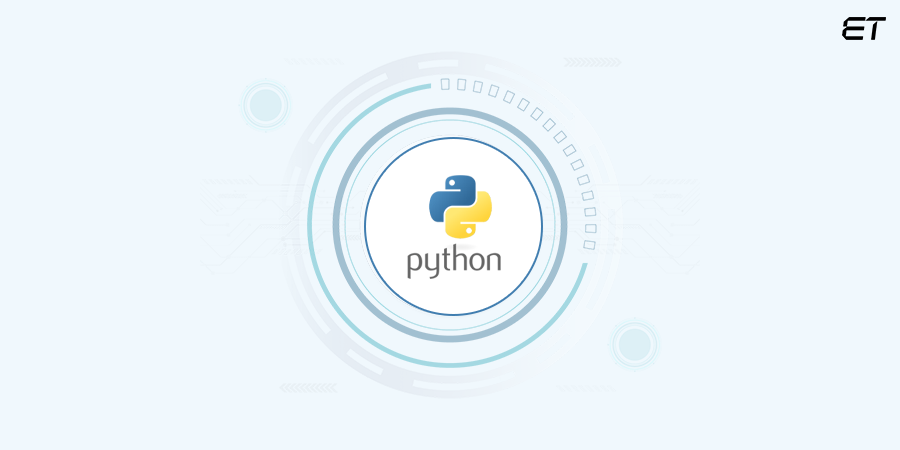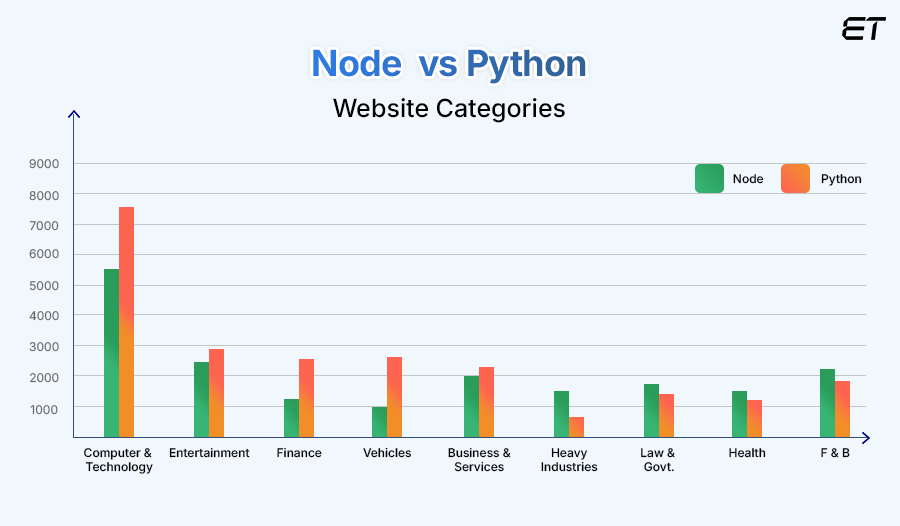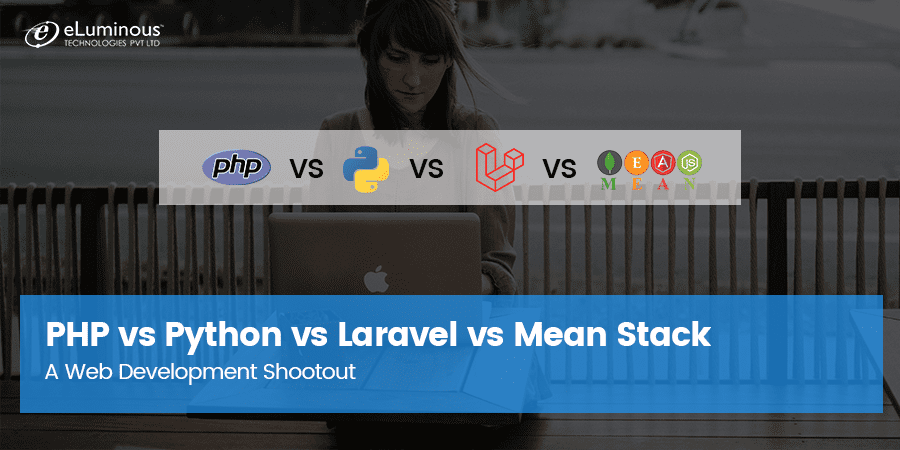When it comes to building the backbone of your digital platform, the choice of backend technology is vital. Did you know, today 70% of digital transformation initiatives fail due to poor technology choices? Thus, it’s essential to align your backend selection with your business goals and project requirements to increase the chances of success.
Two of the most popular programming languages you’ll hear about are Node.js and Python. Both have their strengths, and are widely used across various industries. But, they both serve different purposes and needs; the right choice depends on your specific project requirements.
Node.js is known for its speed and efficiency, whereas Python for its simplicity and versatility. With each offering distinct advantages, how do you determine which one is the best fit for your business?
In this blog, we’ll explore differences between Node.js vs Python helping you make an informed decision that meets your needs and supports long-term growth.
Let’s get started!
Understanding Node.js and Python
Before we explore the differences between Node.js vs Python, first let’s understand them individually, what they are and what they bring to the table.
What is Node.js?
Node.js is a runtime environment that allows you to execute JavaScript code on the server side. It is created to build scalable network applications, and has gained immense popularity for its efficiency, particularly in handling real-time applications and microservices architecture. It’s fast, lightweight, and highly efficient in managing asynchronous operations, which makes it a go-to for you if you’re focused on performance.
For example, imagine you want to develop a real-time chat application like Skype or WhatsApp. In this scenario Node.js is the perfect solution. With Node.js, you can easily handle thousands of users sending and receiving messages simultaneously. Its non-blocking I/O allows your server to handle multiple requests without delay, ensuring the messages are delivered instantly. The number of active users does not affect the speed of your application.
Companies like Uber use Node.js for this very reason, enabling their platform to manage millions of requests per second while maining the application’s speed and performance.
What is Python?
Python, on the other hand, is a high-level, interpreted programming language known for its readability and simplicity. Python is a general-purpose language that has found widespread use in web development, data science, artificial intelligence, and more. Its extensive libraries and frameworks, such as Django and Flask, make it a versatile choice for building a variety of applications, from simple scripts to complex enterprise solutions.
For Example, let’s say you’re working on a project that involves building a recommendation system for an e-commerce platform, similar to what Amazon uses. In this scenario, Python will be a great fit for your project because of its libraries like Scikit-learn and Pandas. These libraries simplify the process of analyzing customer data and creating machine learning models. By using Python, you can develop algorithms that suggest products based on user behavior, past purchases, and browsing history. This capability allows your application to personalize the experience for each customer, driving engagement and sales.
Companies like Facebook use Python for ease of use for their customers and for its data-intensive nature.
Want to learn more about other programming languages?
Node.js vs Python – Detailed Comparison
When it comes to performance, the debate between Node.js vs Python is often about speed and efficiency.
But, before we move forward with the comparison of Node.js vs Python in detail, let’s take a quick glance at the table below:
| Criteria | NodeJS | Python |
| Performance |
It is known for its speed and efficiency, especially in handling I/O operations and is ideal for real-time applications. |
Slower in execution compared to Node.js, particularly in heavy computational tasks and is ideal for large-scale applications. |
| Scalability | Built to scale both vertically and horizontally with microservices architecture. | Scales well using frameworks like Django and Flask. |
| Learning Curve and Syntax | It utilizes JavaScript, enabling seamless full-stack development. It will be familiar if you know JavaScript but mastering asynchronous programming can be challenging. | It features simple, readable syntax resembling plain English and offers a gentler learning curve with extensive resources, making it easier if you’re a beginner. |
| Development Speed | Promotes rapid development with a vast library of modules. Ideal for agile environments and projects with tight deadlines. | Faster development cycles due to its readable syntax. Ideal for prototyping and iterative development. |
| Ecosystem and Libraries | Extensive ecosystem and expanding with time, powered by NPM with millions of packages. | Impressive ecosystem with an already developed and mature one. |
| Security Considerations | Extensive ecosystem and expanding with time, powered by NPM with millions of packages. | Impressive ecosystem with an already developed and mature one. |
| Use Cases | Used by companies like Uber, PayPal, LinkedIn. | Used by companies like Facebook, Instagram, Quora. |
| Community and Support | Rapidly growing community with active contributions. Open-source nature ensures continuous evolution. | One of the largest and most mature communities. Reliable for long-term projects and exploring new areas like AI. |
1. Performance
When comparing Node.js vs Python for backend development, performance is a crucial factor to consider.
Node.js is renowned for its speed and efficiency, especially in handling I/O operations. Its event-driven architecture and non-blocking I/O make it highly performant in scenarios where you can execute tasks asynchronously, such as real-time applications like chatbots, online gaming, or streaming services. It allows your server to handle multiple connections simultaneously. If you have an application that requires quick responses to a large number of users, Node.js is your go to.
In the discussion of Node.js vs Python performance, Python, while incredibly versatile, does not match the raw speed of Node.js.
Python, while incredibly versatile, does not match the raw speed of Node.js. Being an interpreted language, Python tends to be slower in execution compared to Node.js, especially if your application involves heavy computational tasks. However, it’s ideal for your application if execution speed is not your primary concern, such as data analysis, machine learning, or backend web development using frameworks like Django or Flask.
2. Learning Curve and Syntax
Node.js uses JavaScript, which is the universal language of web development. If you’re already familiar with JavaScript for front-end development, transitioning to Node.js for back-end development can be relatively seamless for you. This allows you to use a single language across your entire application stack, simplifying development. However, mastering Node.js involves understanding its asynchronous, non-blocking I/O model and event-driven architecture, which can be challenging if you’re accustomed to synchronous programming.
On the other hand, Python is renowned for its simplicity and readability. Its syntax is clean and straightforward, resembling plain English, which makes it an excellent choice if you’re new to programming. Python enforces indentation and has a minimalistic syntax, helping you write clear and maintainable code. This lowers the barrier to entry and shortens the learning curve, enabling you to become productive more quickly. Additionally, Python’s vast educational resources and supportive community make it easier for you to learn and troubleshoot issues.
3. Scalability
Node.js is built to scale, both vertically and horizontally. Its microservices architecture allows you to break down your application into smaller and more manageable services so that you can scale it independently. This modular approach makes it easier for you to add new features, manage increased user load, and maintain performance as your business grows. Companies like LinkedIn and Netflix have leveraged Node.js for this very reason and are successfully scaling their platforms to serve millions of users efficiently.
Whereas Python’s, scalability comes from its robust ecosystem and flexibility. Frameworks like Django and Flask provide tools for building your scalable web applications, offering you features like caching, database management, and middleware integration. While Python may require more resources to achieve the same level of concurrency as Node.js, its ability to handle complex tasks and integrate with other technologies makes it a solid choice if you’re building large-scale applications, especially those that involve data analytics, AI, or ML.
4. Development Speed
Node.js promotes rapid development because of its vast library of modules available through NPM. This ecosystem allows you to quickly implement features and deploy applications, which is especially valuable in agile development environments. If you are a startup or have projects with tight deadlines, Node.js is preferable as it offers the speed and flexibility to get your products to market quickly without compromising on quality.
On the other hand, Python is designed for simplicity, which translates into faster development cycles. Its readable syntax reduces the likelihood of errors, making it easier for you to write and maintain code. Python is particularly well-suited for prototyping and iterative development that allows you to make quick adjustments and changes whenever necessary. If you’re looking to build a Minimum Viable Product (MVP) or need to pivot rapidly based on your user’s feedback, Python’s development speed can give you a significant advantage.
Get your Python project on track today!
5. Ecosystem and Libraries
Node.js boasts an extensive ecosystem powered by NPM, which is home to millions of packages that can be easily integrated into projects. Whether you need tools for server-side scripting, managing databases, or building RESTful APIs, there’s a package for it in the Node.js ecosystem. This robust library support allows you to avoid reinventing the wheel and instead focus on building custom features that differentiate your applications from others.
Python’s ecosystem is equally impressive, particularly in fields like data science, artificial intelligence, and machine learning. Python’s libraries, such as NumPy, Pandas, TensorFlow, and Scikit-learn, are unmatched in their capabilities, making Python the preferred language for your data-driven projects. In web development, frameworks like Django and Flask provide you powerful tools for building robust web applications with ease.
6. Security Considerations
Node.js is generally considered secure, but like any technology, it has its vulnerabilities. Common security issues include insecure modules, vulnerabilities in third-party packages, and poor implementation of security practices. However, if you give proper attention to coding practices and regular updates, you can avoid or overcome these risks.
Python is known for its strong security features, particularly in frameworks like Django, which includes built-in protection against common vulnerabilities like SQL injection, cross-site scripting (XSS), and cross-site request forgery (CSRF). You can also benefit from its mature ecosystem as it has a large community that actively contributes to identifying and patching security flaws.
7. Use Cases
Node.js is highly versatile, particularly if your applications require real-time data processing or a high level of concurrency. It’s an excellent choice for you to build APIs, single-page applications (SPAs), and microservices. Companies like Uber and PayPal have successfully used Node.js to build scalable, high-performance applications that can handle millions of requests per minute.
Python’s versatility is unmatched when it comes to scientific computing, data analysis, and machine learning. You can prefer this language for projects involving complex algorithms, data visualization, and automation. Also, Python is highly preferable for web development, especially if you’re looking to build data-driven applications or integrate AI features into your application. Companies like Google and Instagram rely on Python for its ability to handle a wide range of tasks efficiently.
8. Community and Support
The Node.js community is growing rapidly, with active contributions from developers around the world. This community ensures to support you, whether you need to troubleshoot an issue, find a new library, or learn about the latest developments. Its open-source nature ensures that it continues to evolve in response to your (users) needs.
Python’s community is one of the largest and most mature in the programming world. With decades of development, Python has extensive documentation, tutorials, and community-driven improvements. Whether you’re looking for support with a niche problem or exploring new areas like AI, Python’s community is there to help, making it your reliable choice for long-term projects.
Below image shows the comparison of the usage of Node.js vs Python across different industries:
Looking for expert developers for your next project?
Node.js vs Python: Which is More Popular?
When it comes to popularity, Node.js and Python are both highly regarded, but they cater to different developer needs and use cases.
Here’s a closer look at their popularity based on various factors:
1. Community Support and Ecosystem
- Python: With decades of development, Python boasts a massive community and an extensive ecosystem of libraries for data science, machine learning, web development, and more.
- Node.js: Backed by JavaScript’s immense community, Node.js enjoys widespread use, especially in building scalable server-side applications and real-time web solutions.
2. Use Cases and Adoption
- Python: Popular in fields like AI, machine learning, data analytics, and backend web development (Django, Flask). Companies like Google and Netflix use Python extensively for data-driven solutions.
- Node.js: Dominates real-time applications, such as chat apps, gaming servers, and APIs, thanks to its non-blocking, asynchronous nature. Companies like LinkedIn, Uber, and PayPal rely on Node.js for their web performance needs.
3. Learning Curve and Flexibility
- Python: Known for its beginner-friendly syntax, Python is widely taught in universities and is the go-to language for newcomers to coding and AI.
- Node.js: Requires familiarity with JavaScript, making it more suitable for developers already comfortable with front-end development who want to transition into full-stack roles.
4. Popularity Metrics
- Python: According to developer surveys such as Stack Overflow’s Developer Survey, Python consistently ranks among the top 3 most-used languages globally, especially in data science.
- Node.js: As a runtime, ranks high in terms of backend development, especially for enterprise-grade applications.
Change h2 “Key Differences Between Node.js vs Python” to “Node.js vs Python – Detailed Comparison”
Node.js vs Python — What to Choose?
When choosing between Node.js vs Python for backend development, your decision must largely depend on your project’s specific requirements. Node.js is ideal if you need speed and efficiency for real-time applications like chat platforms or streaming services because of its non-blocking I/O and event-driven architecture. It’s also well-suited if your project requires rapid development and scalability, especially when considering Node.js vs Python performance.
On the other hand, Python excels in data-driven applications, machine learning, and web development, especially if you need simplicity, readability, and access to extensive libraries for your project. If it involves complex algorithms, data analysis, or integrating AI features, Python’s robust ecosystem and mature security frameworks make it a strong contender. Ultimately, your choice should align with the specific demands of your application and long-term business goals.
Wrapping Up!
In the end, the choice between Node.js and Python depends on the specific needs of your project and your long-term business goals. By understanding the strengths and trade-offs of each, you can make a decision that drives your business forward and sets your project up for success.
We hope this blog helps your decision making. For any queries regarding Node.js vs Python, and your development project, you can always reach out to our experts!
Frequently Asked Questions
1. Node.js vs Python — which is faster?
Node.js is generally faster than Python, especially for real-time applications.
2. Which is better for machine learning — Node.js vs Python?
Python is best suited for your machine learning projects because of its vast array of libraries which are specifically designed for ML tasks.
3. Can I scale applications built with Python as effectively as with Node.js?
Yes you can scale applications built with Python by using frameworks like Django and Flask. However, Node.js is often more efficient for scaling due to its architecture.

Project Delivery Head
Nitin has over 20 years of IT experience and 3+ years of experience in on-site work in Arizona, USA. In all these years, he has held the positions of delivery manager, module lead, and senior consultant. Expert in advocating product life cycle phases while using self-motivational skills and problem-solving abilities. He works on the principle of “Always Deliver More than Expected.”
